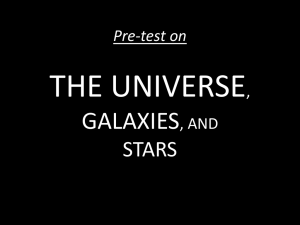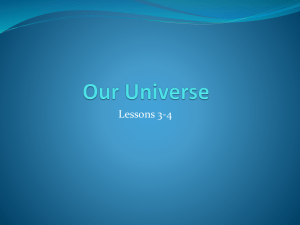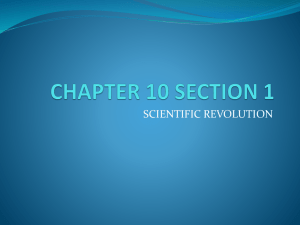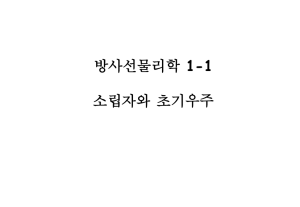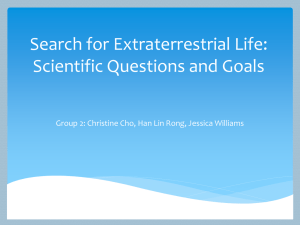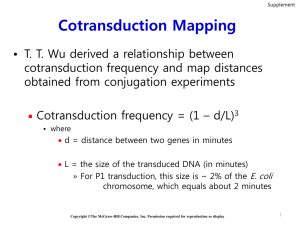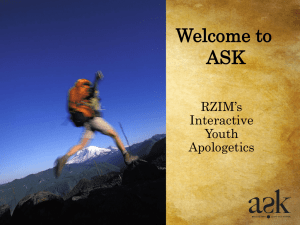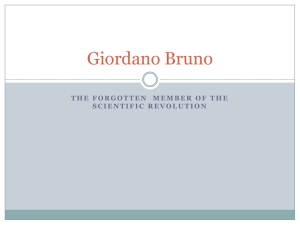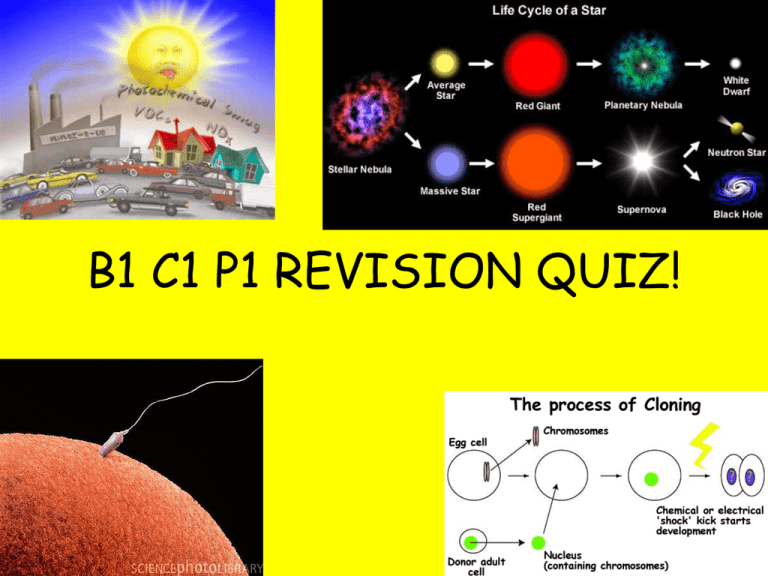
B1 C1 P1 REVISION QUIZ!
B1 You and Your Genes
1. Put these words in the correct order of their
size from smallest to largest.
B1 You and Your Genes
2. Place the following characteristics into the
correct category.
EYE COLOUR, SCAR, NATURAL HAIR COLOUR
BLOOD GROUP, TATTOOS, PIERCINGS
Inherited
Environmental
B1 You and Your Genes
3. Complete the diagram below to show how
identical twins are formed.
SPERM CELL
FERTILISATION
FERTILISED EGG CELL
EGG CELL
…?
B1 You and Your Genes
4. Identical twins and spider plants are examples
of natural clones.
Write a definition for the word ‘clone’.
B1 You and Your Genes
5. Chromosome numbers! How many
chromosomes will the following human cells have?
a) A male body cell?
b) A male sex cell (sperm)?
c) A female body cell?
d) A female sex cell (egg)?
e) A fertilised egg cell?
B1 You and Your Genes
6. Genetic diseases.
a) This man has Huntington’s
disease. Give two symptoms he
may suffer from.
b) This young girl has cystic fibrosis.
Give two symptoms she may suffer
from.
B1 You and Your Genes
6. Male or female?
What sex chromosome(s) would be in the
nucleus of:
a) A man’s body cell?
b) An egg cell?
c) A woman’s body cell?
d) A sperm cell?
B1 You and Your Genes
7. Genetic cross diagrams (part 1).
The height of these people is determined by two
genes: T is dominant and produces tall people; t is
recessive and produces short people.
Giant
(male)
a) List the possible genotype(s) of
Giant.
b) List the possible genotype(s) of
Shorty.
Shorty
(female)
B1 You and Your Genes
7. Genetic cross diagrams (part 2).
Use your answers to 7a and 7b to help with these
questions.
c) Giant has a gene pair that is
homozygous. If he and Shorty
were to have child, what would
the childrens’ genotype be?
d) What is the phenotype of the
children?
Giant
(male)
Shorty
(female)
B1 You and Your Genes
8. Genetic testing.
Elaine and Peter are worried about the health of
their unborn child as Elaine’s nephew has just
been diagnosed with cystic fibrosis.
a) Is there a chance that Elaine and Peter’s
unborn child may have cystic fibrosis?
b) How could they find out for sure?
c) Give two ethical issues of choosing to find
out for sure.
B1 You and Your Genes
9.
a) What does the phrase IVF stand for?
b) Describe what pre-implantation genetic
diagnosis (PGD) is used for.
c) Write a step-by-step guide on how PGD is
carried out.
B1 You and Your Genes
10.
a) Write a definition for ‘stem cells’.
b) Give one reason why embryonic stem cells
are considered very important for scientific
research.
C1 Air Quality
1. Composition of air.
gas A
a)Name gases A
and B.
gas B
b)Name the main
gas that makes
up the ‘1%
Other’ category.
C1 Air Quality
2. The atmosphere of early Earth.
For each of the following gases, state whether it
is now present in a higher, lower or the same
concentration in comparison to early Earth’s
atmosphere.
a) Carbon dioxide
b) Water vapour
c) Oxygen
C1 Air Quality
3. Air pollutants
a) Name these five air pollutants from their
chemical symbols: SO2, CO, CO2, NO, NO2
b) Name one air pollutant that can cause acid
rain.
c) Name one air pollutant that can change the
amount of oxygen in the blood.
d) Name one air pollutant, not listed above, that
is deposited on surfaces, making them dirty.
C1 Air Quality
4. Analysing data. Match the keyword to its definition.
A. Accuracy
1. Shows how close a result is to
the true value.
B. Outlier
2. The best estimate calculated
using a range of values.
C. Range
3. A result that is very different to
the others.
D. Mean
4. The variation in a set of results,
from the highest to the lowest.
C1 Air Quality
5. Burning fuels
a) Name the two products formed when natural
gas (methane, CH4) is burnt in plenty of oxygen.
b) Name two other products also formed if the
natural gas is burnt in a limited supply of oxygen.
c) In car engines, nitrogen monoxide can also be
formed, in addition to the four products above.
Explain how the nitrogen monoxide is formed.
C1 Air Quality
6. Particle diagrams and conservation of atoms.
Complete the diagram below to show the products. [3]
O O
H
H
C
H
H
Methane
+
O O
Oxygen
+
Carbon dioxide
Water
C1 Air Quality
Number of prescriptions for
hay fever medication (per
1000 of population)
700
600
500
400
300
200
100
0
0
5
Month
10
7. On this graph, the
blue line shows
number of hayfever
prescriptions per
month. The black line
shows pollen count
per month.
Does this graph prove that pollen causes hayfever
symptoms? Explain your answer. [3]
C1 Air Quality
8. Asthma
a) Give two examples of things that may trigger an
asthma attack.
b) Scientists are still researching asthma to develop
a full understanding of the condition. Why it is
important that scientists publish their data and
explanations?
C1 Air Quality
9. Reducing pollutants from cars
a) Which two pollutants are removed by catalytic
converters?
b) For each of pollutant, which less harmful gas is it
converted into?
c) How has low-sulfur fuel helped to reduce pollution?
d) Electirc cars do not produce any
pollutants when they are used.
However, they are not considered
to be totally pollution-free. Why?
C1 Air Quality
10. Reducing pollutants from power stations.
a) This machine carries out wet
scrubbing to remove an
acidic pollutant gas from
factory gas outlets. Name the
pollutant gas it removes.
b) Describe how an electrostatic
precipitator removes
particulates from factory gas
outlets.
P1 The Earth in the Universe
1. Place these words in order of size, from the
smallest to the largest.
P1 The Earth in the Universe
2. Write definitions for these words
a) Comet
b) Asteroid
c) Light year
d) Fusion
P1 The Earth in the Universe
3. Measuring distances
a) Explain how scientists would use parallax to determine
whether Star 1 or Star 2 is closer to Earth.
b) Star 1 and Star 2
are of the same
type. Explain how
scientists would
use brightness to
determine which
of the two stars is
closer to Earth.
Earth in
June
Star 2
Earth in
December
Star 1
P1 The Earth in the Universe
4. The start of the Universe
a) State the approximate age of the Universe.
b) State the approximate age of the Earth.
c) Give one piece of evidence that supports the big
bang theory.
P1 The Earth in the Universe
5. Dating rocks. Use the diagram to answer the questions.
a) Which letter
represents the
oldest layer of rock?
b) Which letter
represent the
youngest layer of
rock?
c) Which of H or M is
likely to be the
youngest rock?
P1 The Earth in the Universe
6. Continental drift.
a) Name the scientist who came up with the theory
of continental drift.
b) Use the diagram on the
right to give two pieces
of evidence that
support his theory.
P1 The Earth in the Universe
7. Write down the keywords that fill the gaps.
The Earth’s crust is made up of ____1_____ plates that flow
very slowly over the layer beneath them, called the ___2___.
The ocean floor continually grows wider where plates are
moving ____3____. This is know as seafloor ____4______.
Ocean floor is destroyed where plates are moving
______5______. Sometimes the meeting of two plates can
result in rocks buckling and folding upwards to form
______6_______.
The friction of plates moving side-by-side along fault lines can
cause ______7_________.
P1 The Earth in the Universe
8. Detecting Earthquakes.
a) Draw a longitudinal wave (a P wave)
b) Label it with compression, rarefaction and
wavelength.
c) Draw a transverse wave (an S wave)
d) Label it with wavelength and amplitude.
e) What is the frequency of a wave?
P1 The Earth in the Universe
9. The wave equation.
Wave speed (m/s) = frequency (Hz) x wavelength (m)
a)A seismic wave travelling through rock has a
frequency of 0.5 Hz. The wavelength is 20 km.
Calculate the speed of the wave.
b)The same wave passes into a different rock
where the speed is 14 m/s. What
will the new wavelength be?
P1 The Earth in the Universe
10. Using waves.
Scientist studies of the
movement of seismic
waves have informed us
about the structure of
the Earth.
a) What does the S-wave
shadow zone tell us
about the structure of
the core?
b) Explain what causes
the S-wave shadow
zone.
B1 C1 P1 REVISION QUIZ!
ANSWERS
B1 You and Your Genes
1. Put these words in the correct order of their
size from smallest to largest.
B1 You and Your Genes
2. Place the following characteristics into the
correct category.
EYE COLOUR, SCAR, NATURAL HAIR COLOUR
BLOOD GROUP, TATTOOS, PIERCINGS
Inherited
EYE COLOUR
NATURAL HAIR
COLOUR
BLOOD GROUP
Environmental
SCAR
TATTOOS
PIERCINGS
B1 You and Your Genes
3. Complete the diagram below to show how
identical twins are formed.
BABY
SPERM CELL
FERTILISATION
CELL SPLITS
FERTILISED EGG CELL
EGG CELL
BABY
B1 You and Your Genes
4. Identical twins and spider plants are examples
of natural clones.
Write a definition for the word ‘clone’.
Organisms / living
things that are
genetically identical /
genetically the same /
have the same genes.
B1 You and Your Genes
5. Chromosome numbers! How many
chromosomes will the following human cells have?
a) A male body cell? 46
b) A male sex cell (sperm)? 23
c) A female body cell? 46
d) A female sex cell (egg)? 23
e) A fertilised egg cell? 46
B1 You and Your Genes
6. Genetic diseases.
a) This man has Huntington’s
disease. Give two symptoms he
may suffer from.
Forgetfulness, memory
loss, staggering, loss of
balance, falling over.
b) This young girl has cystic fibrosis.
Give two symptoms she may suffer
from. Thick mucus in lungs, breathlessness, regular
chest infections, malnutrition, digestive problems
B1 You and Your Genes
6. Male or female?
What sex chromosome(s) would be in the
nucleus of:
a) A man’s body cell? XY
b) An egg cell? X
c) A woman’s body cell? XX
d) A sperm cell? X or Y
B1 You and Your Genes
7. Genetic cross diagrams (part 1).
The height of these people is determined by two
genes: T is dominant and produces tall people; t is
recessive and produces short people.
Giant
(male)
a) List the possible genotype(s) of
Giant. TT or Tt
b) List the possible genotype(s) of
Shorty. tt
Shorty
(female)
B1 You and Your Genes
7. Genetic cross diagrams (part 2).
Use your answers to 7a and 7b to help with these
questions.
c) Giant has a gene pair that is
homozygous. If he and Shorty
were to have child, what would
the childrens’ genotype be? All Tt
d) What is the phenotype of the
children? All tall
Giant
(male)
Shorty
(female)
B1 You and Your Genes
8. Genetic testing.
Elaine and Peter are worried about the health of their unborn
child as Elaine’s nephew has just been diagnosed with cystic
fibrosis.
a) Is there a chance that Elaine and Peter’s unborn child may
have cystic fibrosis? Yes
b) How could they find out for sure? Genetic testing of foetus
via aminocentesis or chorionic villus tests.
c) Give two ethical issues of choosing to find out for sure. Tests
carry small risk of miscarriage. Very small risk of infection.
Results are not 100% (may get false negative or false
positive). May have to choose whether to continue with
pregnancy or have a termination. Etc.
B1 You and Your Genes
9. a) What does the phrase IVF stand for? In vitro fertilisation.
a) Describe what pre-implantation genetic diagnosis (PGD) is
used for. To screen IVF embryos before they are implanted,
to check for genetic diseases.
b) Write a step-by-step guide on how PGD is carried out. Sperm
fertilise eggs in a petri dish. Fertilised eggs allowed to
develop until 8-cell stage. One cell removed from each
embryo and tests for genetic diseases. Only embryos free
from disease are implanted into a female’s uterus.
B1 You and Your Genes
10.
a) Write a definition for ‘stem cells’. Unspecialised
cells.
b) Give one reason why embryonic stem cells are
considered very important for scientific research.
Can grow into any cell type in human body. Can be
used to treat diseases. Could be
used in cloning to create a
genetic match. Etc.
C1 Air Quality
1. Composition of air.
gas A
gas B
a)Name gases A
and B. A =
nitrogen, B =
oxygen
b)Name the main
gas that makes
up the ‘1%
Other’ category.
Argon.
C1 Air Quality
2. The atmosphere of early Earth.
For each of the following gases, state whether it
is now present in a higher, lower or the same
concentration in comparison to early Earth’s
atmosphere.
a) Carbon dioxide LOWER
b) Water vapour LOWER
c) Oxygen HIGHER
C1 Air Quality
3. Air pollutants
a) Name these five air pollutants from their chemical symbols:
SO2 = sulphur dioxide, CO = carbon monoxide, CO2 = carbon
dioxide, NO = nitrogen monoxide, NO2 = nitrogen dioxide
b) Name one air pollutant that can cause acid rain. Sulphur
dioxide or nitrogen dioxide.
c) Name one air pollutant that can change the amount of
oxygen in the blood. Carbon monoxide.
d) Name one air pollutant, not listed above, that is deposited
on surfaces, making them dirty. Particulates.
C1 Air Quality
4. Analysing data. Match the keyword to its definition.
A. Accuracy
1. Shows how close a result is to
the true value.
B. Outlier
2. The best estimate calculated
using a range of values.
C. Range
3. A result that is very different to
the others.
D. Mean
4. The variation in a set of results,
from the highest to the lowest.
C1 Air Quality
5. Burning fuels
a) Name the two products formed when natural gas (methane, CH4)
is burnt in plenty of oxygen. Carbon dioxide, water.
b) Name two other products also formed if the natural gas is burnt
in a limited supply of oxygen. Carbon monoxide, particulates.
c) In car engines, nitrogen monoxide can also be formed, in addition
to the four products above. Explain how the nitrogen monoxide is
formed. Formed when nitrogen in the air reacts with oxygen
under high pressure and temperature in the car engine.
C1 Air Quality
6. Particle diagrams and conservation of atoms.
Complete the diagram below to show the products.
O O
H
H
C
H
H
Methane
+
O O
Oxygen
H
O
C O
+
Carbon dioxide
H
H
O
O
H
Water
C1 Air Quality
Number of prescriptions for
hay fever medication (per
1000 of population)
700
600
500
400
300
200
100
0
0
5
10
7. On this graph, the
blue line shows
number of hayfever
prescriptions per
month. The black line
shows pollen count
per month.
Month
Does this graph prove that pollen causes hayfever symptoms?
Explain your answer. [3] No. It shows a correlation. Correlation does
not prove cause. There could be another (3rd) factor cause the
correlation.
C1 Air Quality
8. Asthma
a) Give two examples of things that may trigger an asthma attack.
Tree or grass pollen, animal skin flakes, nuts, shellfish, air
pollution, dust, getting emotional, stress, exercise, colds, etc.
b) Scientists are still researching asthma to develop a full
understanding of the condition. Why it is important that
scientists publish their data and explanations? Other scientists
can evaluate their claims, check their method of investigation,
presentation of data, way they interpret data, conclusions. This
is peer review.
C1 Air Quality
9. Reducing pollutants from cars
a) Which two pollutants are removed by catalytic converters?
Carbon monoxide and nitrogen monoxide.
b) For each of pollutant, which less harmful gas is it converted into?
Carbon monoxide carbon dioxide, nitrogen monoxide
nitrogen and oxygen.
c) How has low-sulfur fuel helped to reduce pollution? Reduced
amount of sulphur dioxide produced.
d) Electirc cars do not produce any pollutants when they are used.
However, they are not considered to be totally pollution-free.
Why? Because production of electricity requires burning fossil
fuels and therefore still produces pollutants.
C1 Air Quality
10. Reducing pollutants from power stations.
a) This machine carries out wet
scrubbing to remove an acidic
pollutant gas from factory gas
outlets. Name the pollutant gas it
removes. Sulphur dioxide.
b) Describe how an electrostatic
precipitator removes particulates
from factory gas outlets. It gives
particulates a negative charge.
They are attracted to a positively
charged collecting plate so
removed from the waste gases.
P1 The Earth in the Universe
1. Place these words in order of size, from the
smallest to the largest.
P1 The Earth in the Universe
2. Write definitions for these words
a) Comet = large ball of dust and ice
b) Asteroid = small and rocky orbiting the Sun in a band
between Mars and Jupiter.
c) Light year = a unit of distance used by astronomers. The
distance that light travels in a year
d) Fusion = Joining smaller
nuclei together to make
larger elements. Releases
energy. Occurs inside the Sun.
P1 The Earth in the Universe
3. Measuring distances
a)
Explain how scientists would use parallax to determine whether Star 1 or Star 2
is closer to Earth. Observe distant stars behind both Star 1 and Star 2 in both
June and December. The closest Star is the one that shows the largest change
in the distant stars as its background.
b) Star 1 and Star 2 are of
the same type. Explain how
scientists would use
brightness to determine
which of the two stars is
closer to Earth.
Closest star will be the
brightest one.
Earth in
June
Star 2
Earth in
December
Star 1
P1 The Earth in the Universe
4. The start of the Universe
a) State the approximate age of the Universe. 13,700
million years old.
b) State the approximate age of the Earth. 4,500 million
years old.
c) Give one piece of evidence that supports the big bang
theory. Galaxies are moving away from each other.
Universe is getting bigger. Space is expanding. Red
shift. Presence of cosmic microwave background
radiation. Oldest stars are younger than predicted age
of Universe. Etc.
P1 The Earth in the Universe
5. Dating rocks. Use the diagram to answer the questions.
a) Which letter
represents the oldest
layer of rock? I
b) Which letter
represent the
youngest layer of
rock? R
c) Which of H or M is
likely to be the
youngest rock? H
P1 The Earth in the Universe
6. Continental drift.
a) Name the scientist who came up with the theory of
continental drift. Wegener.
b) Use the diagram on the right to give two pieces
of evidence that support his theory. Continents fit
like a jigsaw. Fossils found on
different continents are
identical. Rock types found
on different continents are
identical.
P1 The Earth in the Universe
7. Write down the keywords that fill the gaps.
The Earth’s crust is made up of 1. tectonic plates that flow very
slowly over the layer beneath them, called the 2. mantle.
The ocean floor continually grows wider where plates are
moving 3. apart. This is know as seafloor 4. spreading.
Ocean floor is destroyed where plates are moving 5. towards
each other. Sometimes the meeting of two plates can result in
rocks buckling and folding upwards to form 6. mountains.
The friction of plates moving side-by-side along fault lines can
cause 7. earthquakes.
P1 The Earth in the Universe
8. Detecting Earthquakes.
a)
Draw a longitudinal wave (a P wave)
b)
Label it with compression, rarefaction and wavelength.
c)
Draw a transverse wave (an S wave)
d)
Label it with wavelength and amplitude.
e)
What is the frequency of a wave?
Frequency – number of waves per second.
P1 The Earth in the Universe
9. The wave equation.
Wave speed (m/s) = frequency (Hz) x wavelength (m)
a)A seismic wave travelling through rock has a
frequency of 0.5 Hz. The wavelength is 20 km.
Calculate the speed of the wave. 10000 m/s
b)The same wave passes into a different rock
where the speed is 14 m/s. What
will the new wavelength be? 28m
P1 The Earth in the Universe
10. Using waves.
Scientist studies of the
movement of seismic waves
have informed us about the
structure of the Earth.
a) What does the S-wave
shadow zone tell us about
the structure of the core?
It is liquid.
b) Explain what causes the Swave shadow zone. S
waves cannot travel
through liquid.

